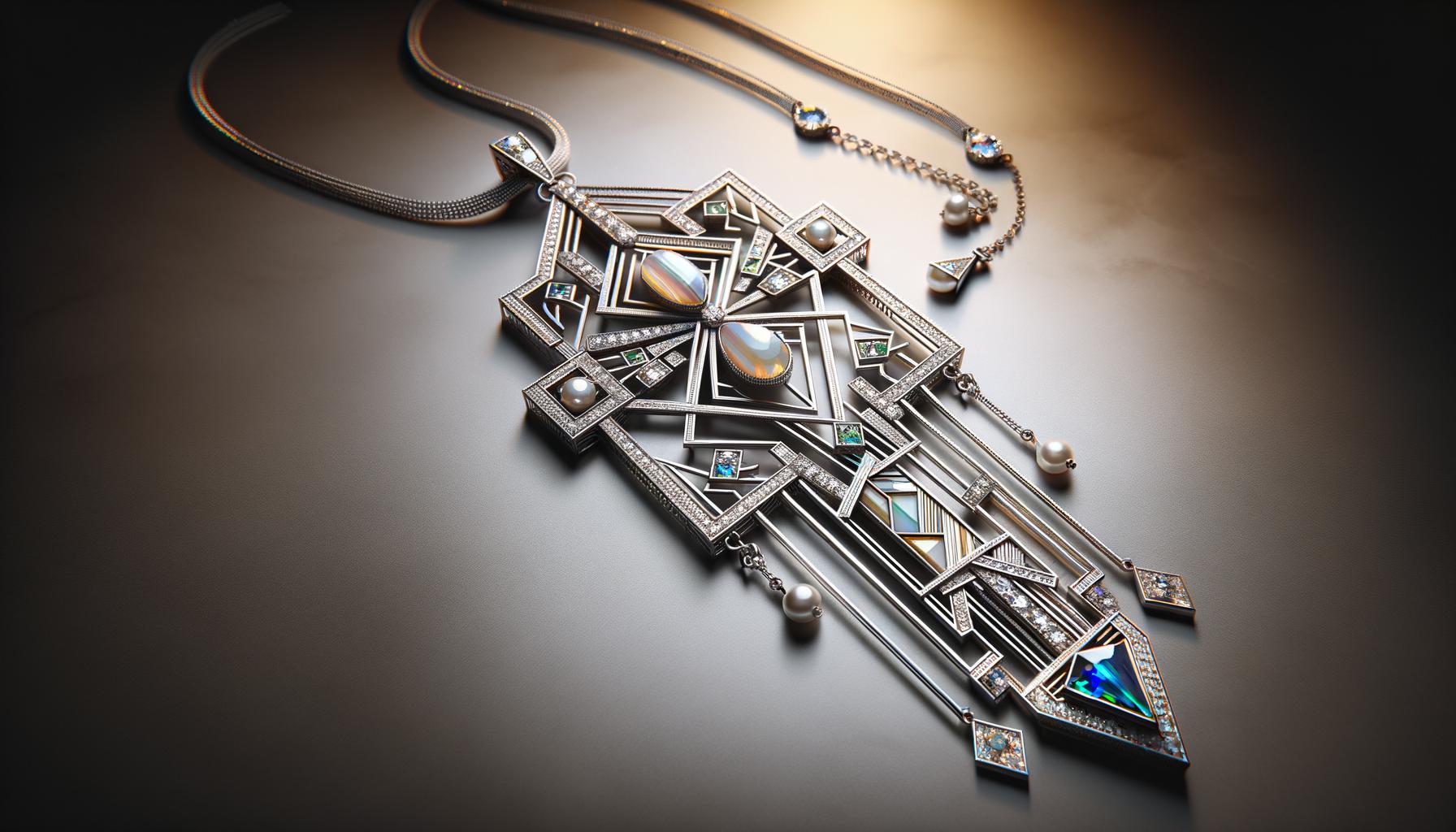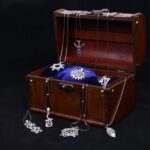Art Deco jewelry: the glamour of the Roaring Twenties, evokes an era marked by opulence, innovation, and a break from traditional design concepts. As the world transitioned from the austerity of World War I to an age of prosperity and modernity, Art Deco emerged as a beacon of change that captivated all aspects of culture, especially fashion and jewelry.
Rooted in optimism and boundless creativity, the Art Deco era gave birth to stunning jewelry pieces that have since become timeless symbols of elegance and sophistication.
The significance of jewelry during the Roaring Twenties cannot be overstated. It was a time when societal norms were being upended, women were embracing newfound freedoms, and personal expression through fashion became a symbol of liberation.
In this context, Art Deco jewelry emerged not only as adornments but also as statements of identity and status. These pieces captured the essence of the decade’s exuberance with their bold geometric shapes, intricate designs, and use of luxurious materials like platinum and diamonds.
In the following sections, we will delve deeper into various facets that make Art Deco jewelry so fascinating. From its historical roots and defining characteristics to profiling iconic designers who shaped its trajectory, each segment will shed light on how this unique style continues to inspire even today.
Readers will explore how social trends influenced these artistic creations, uncover techniques that revolutionized craftsmanship, discover iconic pieces that still mesmerize collectors, and learn how to incorporate vintage Art Deco into modern fashion. Join us on this journey through history as we celebrate the enduring allure of Art Deco jewelry.
The Origins of Art Deco
The Birth of a Movement
The Art Deco movement, which flourished from the 1920s to the 1940s, emerged as a response to the rapid social and technological changes occurring in the aftermath of World War I. It was named after the Exposition Internationale des Arts Décoratifs et Industriels Modernes held in Paris in 1925, where this new style captivated international audiences with its modernist aesthetics that seamlessly blended elegance and functionality.
Art Deco drew inspiration from various sources, including Cubism, Futurism, and ancient civilizations such as Egypt and Mesopotamia, leading to an eclectic mix that set it apart as a distinct visual language.
Influences and Cultural Shifts
The rise of Art Deco jewelry cannot be separated from the cultural shifts of the Roaring Twenties-a decade marked by economic prosperity, industrial innovation, and a progressive liberalization of social norms. Women were entering the workforce in unprecedented numbers and gaining more independence, symbolized vividly by the flapper culture. Jazz music filled nightclubs while cinema became an essential part of leisure life.
These exuberant cultural currents influenced jewelry design profoundly, pushing boundaries towards luxurious excess and geometric precision. Bold geometric shapes, symmetrical patterns, and vibrant gemstones mirrored the era’s fascination with modernity while retaining echoes of timeless grandeur.
Pioneers of Art Deco Jewelry
A cadre of visionary designers played pivotal roles in defining what would become known as art deco jewelry: the glamour of the roaring twenties. Cartier was one such influential figure; his work is renowned for incorporating exotic motifs and high-contrast color combinations involving materials like onyx and jade. Van Cleef & Arpels brought technical ingenuity into play with their ‘mystery setting’ technique, allowing gemstones to appear seamlessly embedded within intricate platinum latticeworks without visible prongs or metal supports.
Raymond Templier’s pieces stood out for their abstraction and innovative use of industrial forms during his tenure at Maison Templier Ainé. Each designer contributed uniquely to embodying both opulence and minimalistic elegance-cornerstones that still define Art Deco jewelry today.
By marrying sophisticated craftsmanship with audacious artistic flair, these key figures created enduring masterpieces that reflected not only individual genius but also captured the electrifying spirit permeating global society during one unforgettably glamorous decade.
Defining Characteristics of Art Deco Jewelry
Art Deco jewelry: the glamour of the Roaring Twenties can be identified through its distinctive characteristics that set it apart from other jewelry styles. One of the most striking features is its use of geometric shapes and symmetrical patterns.
The clean lines, sharp angles, and repetitive motifs embodied a modernist aesthetic that reflected the machine age’s industrial spirit. These designs often included shapes like triangles, rectangles, and chevrons, arranged in intricate symmetrical patterns that caught the eye with their balanced arrangement.
Geometric Mastery
The meticulously designed geometric shapes weren’t merely for visual effect; they represented a break from the organic forms prevalent in previous art movements such as Art Nouveau. This shift towards structured beauty was significant in capturing the zeitgeist of an era obsessed with progress and modernity. The use of exaggerated arches, zigzags, and sunbursts became iconic symbols within this genre, enhancing each piece’s vibrancy without compromising on elegance.
The Bold Marriage of Colors
Another hallmark of Art Deco jewelry was its bold use of color. Unlike earlier periods where soft pastels were predominant, the Roaring Twenties embraced vibrant hues such as deep reds, cobalt blues, emerald greens, and onyx blacks.
These assertive colors were often juxtaposed against each other to create a striking contrast that added to each piece’s allure. Colored gemstones like emeralds, sapphires, rubies alongside diamonds created pieces that shimmered with opulence – an unmistakable nod to the decadence associated with this epoch.
Innovative Materials and Advanced Techniques
Art Deco jewelry also stood out for its innovative materials and advanced techniques. Platinum replaced gold as a popular metal due to its strength and ability to hold elaborate settings securely without adding bulk. Jewelers experimented with unconventional materials like Bakelite-an early plastic-as well as enameling practices that allowed for vivid color applications over metals or stones. Techniques such as pavé settings-where multiple small stones are set close together-enhanced brilliance while maintaining sleek designs.
In essence, Art Deco brought forward an era where glamour was synonymous with innovation; these defining characteristics ensured every piece captured both sophistication and a forward-thinking ethos reflective of one of history’s most dynamic decades.
Iconic Designers and Their Contributions
The Art Deco movement was graced by several iconic designers whose innovative creations have left an indelible mark on the world of jewelry. Among the premier names are Cartier, Van Cleef & Arpels, and Raymond Templier.
Cartier, often celebrated as “The Jeweler of Kings and the King of Jewelers,” brought to life intricate designs characterized by geometric shapes and bold contrast. Their famous Tutti Frutti bracelet exemplifies this combination with its medley of colorful gemstones set against a framework of diamonds, capturing the exuberance and opulence that defined art deco jewelry: the glamour of the roaring twenties.
Van Cleef & Arpels also contributed significantly to the Art Deco era with their commitment to elegance and innovation. Introduced in 1933, their Mystery Set technique-allowing gemstones to be set without visible prongs-became a hallmark of exquisite craftsmanship. Pieces like their Zip necklace, inspired by zippers newly popularized in fashion, showcased flexibility and ingenuity. This clever design allowed the zipper to be worn both as a necklace or a bracelet, reflecting the adaptive spirit of 1920s style.
Meanwhile, Raymond Templier’s work stood out for its avant-garde aesthetic heavily influenced by Cubism and industrial design. His distinctive use of sweeping lines and bold abstractions pushed the boundaries of conventional jewelry design. Templier often employed white gold paired with black enamel to create striking visual contrasts that felt fresh and modern even within an already progressive era. His pieces epitomized streamlined sophistication paired with creative vision.
| Designer | Notable Contribution |
|---|---|
| Cartier | Tutti Frutti Bracelet |
| Van Cleef & Arpels | Mystery Set Technique |
| Raymond Templier | Cubism Influenced Designs |
The Influence of the Roaring Twenties on Art Deco Jewelry
The 1920s, famously known as the Roaring Twenties, were a decade of exuberance and transformation. Social trends and lifestyles during this time had a profound influence on various art forms, including jewelry design. Art deco jewelry: the glamour of the roaring twenties embraced the spirit of innovation and liberation that marked this vibrant period.
Flapper culture, with its emphasis on freedom and self-expression, was particularly impactful. Women began to favor bold, geometric designs that reflected their newfound independence and rejection of Edwardian conservatism.
Jazz music also played a significant role in shaping Art Deco jewelry. The rhythmic, lively genre inspired dynamic patterns and motifs in jewelry pieces. Designers mirrored the spontaneity of jazz with asymmetric arrangements and unexpected combinations of materials. Furthermore, the rise of cinema introduced Hollywood stars as fashion icons, popularizing glamorous accessories adorned by celebrities on screen. Larre necklaces with cascading diamonds or brooches featuring intricate filigree became symbols of sophistication and status.
The liberated spirit was celebrated through opulent use of precious stones and metals. Platinum replaced gold as the metal of choice due to its strength and ability to hold detailed designs without tarnishing. Diamonds were abundantly used to reflect light in innovative ways; however, other materials such as emeralds, sapphires, onyx, coral, jade, ivory also found their place in art deco masterpieces. This mix evoked an era characterized by both excess and elegance.
This transformative period’s extravagance is vividly captured in lists detailing quintessential influences:
- Flapper Culture: Shorter hairstyles (bob cuts), knee-length skirts replacing floor-length gowns.
- Jazz Music: Syncopated rhythms inspiring irregular yet harmonious designs.
- Hollywood Influence: The emergence of style icons like Clara Bow or Louise Brooks who wore luxurious Art Deco jewelry onscreen.
- Material Innovation:
- Platinum: Favored for its resilience.
- Diamonds: Abundant usage representing allure.
- Exotic Elements: Introduction to bakelite among natural stones like coral & jade used innovatively within pieces reflecting cross-cultural inspirations such as Egyptian revival driven from global exposure post World War I exploration narratives shared universally.
Art Deco jewelry exemplifies this blend where each piece narrates tales woven intricately catering visually appealing aesthetics while embodying contemporary relevance capturing essence boldly thriving towards modernity yet drawing immense nostalgic admiration tracing roots back into these inspiring roars echoing timelessly even today.
Art Deco Jewelry Techniques and Materials
The Art Deco era revolutionized jewelry making by combining innovative techniques and a diverse array of materials. The craftsmanship of the 1920s was marked by meticulous attention to detail, resulting in pieces that were both visually stunning and technically sophisticated. Traditional methods were upgraded with new technologies, pushing the boundaries of what was possible in jewelry design. One of the hallmark techniques was intricate metalwork, often utilizing platinum due to its strength and ability to hold elaborate settings securely.
Commonly used materials included precious gemstones such as diamonds, emeralds, rubies, and sapphires. These stones were chosen not only for their beauty but also for their exceptional qualities like clarity and color. Platinum became a preferred metal over gold because it allowed for more delicate filigree work, a defining characteristic of many Art Deco pieces. Additionally, enamel work saw a resurgence during this period, lending vibrant hues and detailed artistry to various pieces.
Nobel materials further elevated the luxurious appeal of Art Deco jewelry: the glamour of the roaring twenties wouldn’t be complete without Bakelite. This early form of plastic was prized for its versatility and ability to be dyed in multiple colors.
Ivory and lacquer also made appearances in extravagant brooches and accessories. Techniques such as millegrain (a granular finish on edges) and calibre-cut stones (stones cut to fit precisely into geometric patterns) were standard practices that exemplified the technical prowess of designers from this period.
- Platinum: Used extensively for its durability and ease in crafting fine details.
- Bakelite: A synthetic material that offered endless possibilities for color experimentation.
- Enamel: Applied in bright shades to enhance visual appeal.
- Millegrain: A granulated detailing technique adding a touch of elegance to designs.
The consummate expertise associated with these techniques ensured that each piece was not just an accessory but an embodiment of modernity and luxury. Whether through complex settings or pioneering materials like Bakelite, Art Deco jewelry makers managed to capture the zeitgeist of the Roaring Twenties, embedding their works with an enduring allure that continues to captivate collectors today.
Popular Art Deco Jewelry Pieces and Styles
Art Deco jewelry remains iconic due to its bold, geometric designs and lavish use of materials. Among the most celebrated pieces from this era is the cocktail ring, a statement piece that exudes both sophistication and exuberance.
These rings were designed to be eye-catching, often featuring large central stones surrounded by smaller ones arranged in intricate patterns. The cocktail ring became synonymous with the newfound freedom and extravagance of the 1920s, as women began attending more social events and wanted impactful accessories to complement their outfits.
Long necklaces were another prevalent style in Art Deco jewelry, often characterized by their luxurious length and elaborate pendants. Flappers popularized these pieces, as their straight, loose-fitting dresses called for accessories that would add elegance without overpowering their look. Beads made from materials like pearls, onyx, or colorful gemstones were commonly used in these necklaces, incorporating elements from different cultural inspirations such as Egyptian motifs or Oriental influences.
Brooches also saw a renaissance during this period, becoming one of the versatile staples in a woman’s jewelry collection. They often featured complex designs with vivid color contrasts achieved through meticulously set gemstones. Egyptian revival was particularly noticeable in brooch designs after the discovery of Tutankhamun’s tomb in 1922 fascinated the western world. Likewise, Cubism influenced many brooch patterns with abstract forms and angular shapes that embodied modernity.
| Jewelry Piece | Characteristics |
|---|---|
| Cocktail Ring | Large central stone surrounded by smaller ones; designed for impact. |
| Long Necklace | Lush length with beads or gemstones; inspired by global cultures. |
| Brooch | Diverse designs; infused with Egyptian revival or Cubist influences. |
Each piece serves as a testament to art deco jewelry: the glamour of the roaring twenties and its emphasis on luxury and innovation. Whether it’s through opulent cocktail rings or intricately designed brooches and necklaces, Art Deco jewelry captures an era when design was about making bold statements and celebrating life’s splendor.
Collecting and Wearing Art Deco Jewelry Today
The market for Art Deco jewelry has seen a resurgence, driven by collectors’ passion for the era’s distinctive designs and the romanticism tied to owning such storied items. Prices can vary widely based on factors like rarity, condition, and provenance.
Top-tier items by famous designers command premium prices at auctions around the world, yet accessible options are available for those new to collecting. When investing in Art Deco jewelry: the glamour of the roaring twenties is not only an aesthetic choice but also a financial consideration-choosing wisely means balancing beauty with potential appreciation in value over time.
Integrating vintage Art Deco pieces into contemporary fashion is an art form that blends historical elegance with modern sensibility. A cocktail ring set with emeralds or onyx can become a statement accessory that elevates any outfit from mundane to magnificent. Long necklaces drape effortlessly over both casual ensembles and evening attire, adding an air of nostalgic sophistication.
For those experimenting with this dynamic blend of past and present styles, start with versatile pieces like brooches or earrings-subtle yet impactful elements that showcase your appreciation for timeless design. Wearing Art Deco jewelry today keeps the legacy alive while celebrating the spirited exuberance of an unforgettable era.
The Lasting Legacy of Art Deco Jewelry
The allure of Art Deco jewelry: the glamour of the roaring twenties, remains as timeless today as it was nearly a century ago. One significant factor contributing to its enduring appeal is its distinct combination of modernism with rich decorative elements from various cultures and epochs drawn into cohesive designs that continue to inspire both collectors and contemporary jewelers alike.
These masterpieces are not merely relics of the past but living testaments to an era marked by brimming creativity and forward-thinking artistry.
Contemporary designers frequently riff on traditional Art Deco motifs and themes, creating pieces that pay homage to history while simultaneously pushing boundaries. The meticulous craftsmanship, characterized by geometric shapes and lavish materials such as platinum, emeralds, and diamonds, provides endless inspiration for modern creations. Designers today might incorporate these classic elements but blend them with new materials or technology, epitomizing how the influence of Roaring Twenties’ bijoux has seamlessly merged with today’s fashion sensibilities.
Moreover, the market for authentic Art Deco pieces continues to thrive, celebrated in auctions worldwide where collectors vie fiercely for these vintage treasures. Museums and private collections regularly showcase exhibitions dedicated to this glittering epoch, underscoring ongoing fascination with the era’s opulence.
From ornate cocktail rings to striking earrings and bold necklaces, owning or wearing an authentic piece is like possessing a fragment of history-a tactile connection to an age where glamour reigned supreme. Through these ongoing appreciations and reinterpretations, Art Deco jewelry retains its seminal place in both historical study and contemporary culture.
Conclusion
Art Deco jewelry remains an emblematic representation of the glamour and exuberance of the Roaring Twenties. This distinctive style epitomized an era defined by bold cultural shifts, technological advancements, and a profound appreciation for artistic innovation.
Through daring geometric shapes, rich colors, and luxurious materials, Art Deco jewelry captured the spirit of a generation seeking to break free from convention and embrace modernity. The exquisite craftsmanship and pioneering designs of renowned jewelers like Cartier, Van Cleef & Arpels, and Raymond Templier continue to inspire admiration and reverence.
Embracing the glamour of the Roaring Twenties through Art Deco jewelry is both a celebration of history and a statement of timeless elegance. Each piece tells a story not only of its creation but also of the zeitgeist that brought it to life.
From dazzling cocktail rings to intricate brooches adorned with vibrant gemstones, these jewels offer glimpses into a world where luxury and artistry were intertwined in exhilarating harmony. As we explore these captivating treasures, we gain a deeper appreciation for the ingenuity and creativity that defined this extraordinary period.
Today, as enthusiasts wear or collect Art Deco jewelry: the glamour of the roaring twenties endures. These timeless pieces effortlessly blend with contemporary fashion while preserving their historical essence.
Whether through an heirloom passed down generations or a rare find in an antique shop, owning a piece of Art Deco jewelry connects us to an era filled with opulence and liberation. By continuing to value and wear these magnificent creations, we not only honor their legacy but also keep alive the very spirit that made them iconic-a true testament to their everlasting allure.
Frequently Asked Questions
What Jewelry Was Popular in the 1920s?
Jewelry in the 1920s was heavily influenced by the Art Deco movement, which embraced modernism and geometric designs. Popular items included long strands of pearls, often doubled or tripled for added flair, and bold cocktail rings with large, colorful gemstones.
Brooches were also a significant accessory, frequently adorned with intricate patterns and exuberant designs. These pieces often featured materials like platinum and white gold, while diamonds and emeralds added a touch of glamour, indicative of the opulent Roaring Twenties lifestyle.
How to Identify Art Deco Jewelry?
Identifying Art Deco jewelry involves looking for specific characteristics that reflect the movement’s emphasis on modernity and sophistication. The designs are typically symmetrical and geometric, showcasing an abundance of clean lines and shapes such as triangles, circles, or zigzags.
Materials commonly used include platinum and white gold set with contrasting colored gemstones like sapphires, rubies, and emeralds alongside diamonds. Additionally, motifs such as chevrons, sunbursts, and Egyptian themes are clues that a piece may be from the Art Deco era.
Who Are the Famous Art Deco Jewellers?
Several renowned jewelers became famous for their exceptional Art Deco creations during its heyday in the 1920s to 1930s. Cartier stands out with its exquisite use of geometry and luxurious materials to create iconic pieces that continue to embody the essence of Art Deco glamour.
Van Cleef & Arpels gained acclaim through intricate designs incorporating innovative techniques such as their “mystery setting.” Another notable name is René Lalique who transitioned from his earlier Art Nouveau style to equally impressive Art Deco jewelry that echoed minimalistic elegance combined with intricate craftsmanship.

Welcome to my jewelry blog! My name is Sarah and I am the owner of this blog.
I love making jewelry and sharing my creations with others.
So whether you’re someone who loves wearing jewelry yourself or simply enjoys learning about it, be sure to check out my blog for insightful posts on everything related to this exciting topic!





